Learn how to make classic basil pesto. It’s so rewarding—easy to make and freezes beautifully to use later! Even if you don’t grow many plants, we have a starter recipe featuring only 10 to 12 leaves!
A row of basil in my little greenhouse had grown more than two feet tall and was way too bushy, extending far beyond its intended space and shading out other plants, so I cut the stems back to within a few inches of the soil.
Hmm. What to do with all those leaves?
Just that day, I’d seen a recipe for a quiche that featured a layer of basil pesto spread across the crust under the cheesy filling.
Make pesto! Of course!
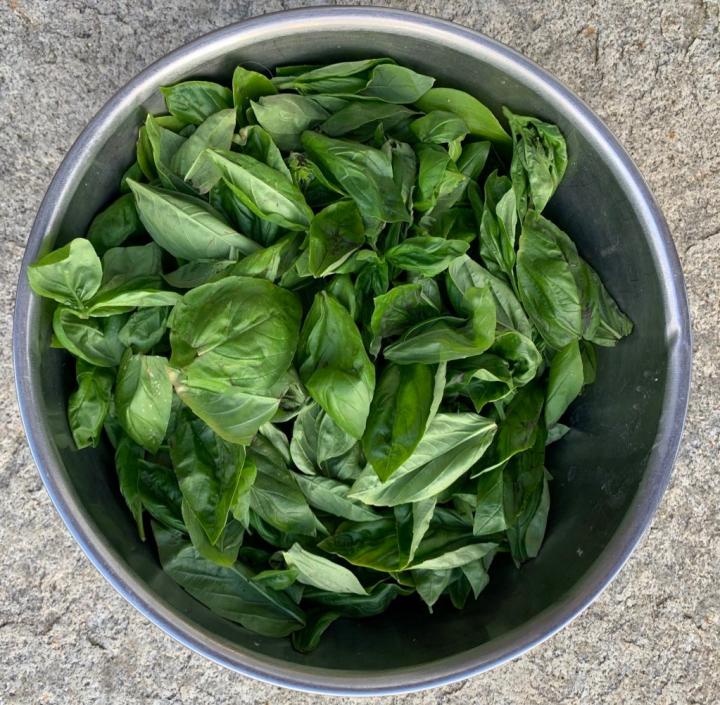
Image: Basil leaves ready for a pesto recipe! Tip: Store basil stems out of the fridge in a tall glass with a little bit of water.
My Basic Basil Pesto Recipe
I rinsed, spun dry, and chopped a big bunch of leaves, removing the tougher stems.
Then, I tossed together the following ingredients in a blender:
- Basil leaves (about 4 cups, loosely packed)
- Three big garlic cloves, minced
- A couple handfuls of walnuts, ground in the coffee grinder I use for seeds/nuts/spices/herbs
- Two or three ounces of (very old) parmesan cheese, shredded.
- Enough good olive oil to whirl everything into a thick sauce in my blender. (Probably easier in a food processor, but I don’t have one.)
I tasted it a couple of times, added a little more cheese and a few more walnuts.
That’s it! I didn’t use a recipe because I’ve looked at many pesto recipes over the years, and made it many times myself, with varying proportions of the same ingredients: fresh basil leaves, garlic, walnuts or pine nuts, freshly grated parmesan, and olive oil. Sometimes I add a squirt of lemon juice, but I didn’t have lemons on hand this time. This batch was quite salty, so I didn’t add that pinch of salt some folks suggest.
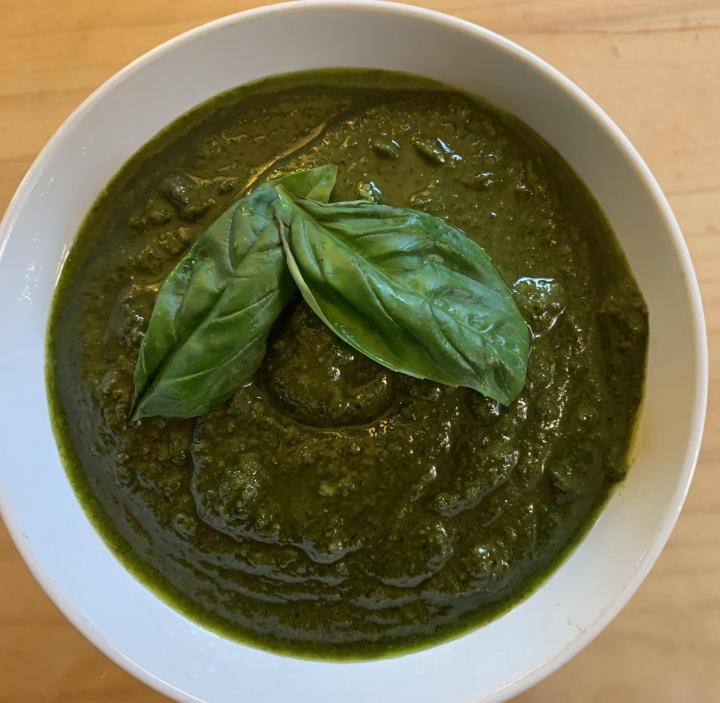
Image: A starter recipe for pesto using a handful of leaves.
Small-Batch Pesto Recipe
Most folks don’t have a big bunch of basil to harvest, however. If you need it, here’s a starter recipe featuring only 10 to 12 leaves:
- 10 large basil leaves, chopped
- 1 large garlic clove, minced
- A few walnuts or pine nuts chopped or ground, enough to make 2-3 tbsp
- 3 or 4 tbsp olive oil, or more to achieve desired consistency
- Chunk of chopped or grated fresh parmesan cheese, 4-5 tbsp, or about an ounce
Put everything into a blender or food processor, olive oil first, pulse it a few times to commingle the ingredients, and blend/puree until it turns into a thick sauce. Drizzle in more olive oil to get a consistency you prefer.
Note: You don’t have to include nuts if you don’t like nuts (which are also expensive).
Freezing Pesto
I used some of the pesto right away and froze the rest in an ice-cube tray. After the cubes were frozen solid, I ran warm water over the bottom of the tray to release them, popped them into a freezer container, and dribbled a little olive oil over them to help them separate when I want to pull a couple out for use.
I also had a lot of leftover basil leaves, so I froze them, tightly packed into a heavy freezer bag. Whenever I need a bit of basil seasoning, I pinch off a few and crush them into flakes. They’ll be dark and wilted, but freezing preserves the rich basil flavor.
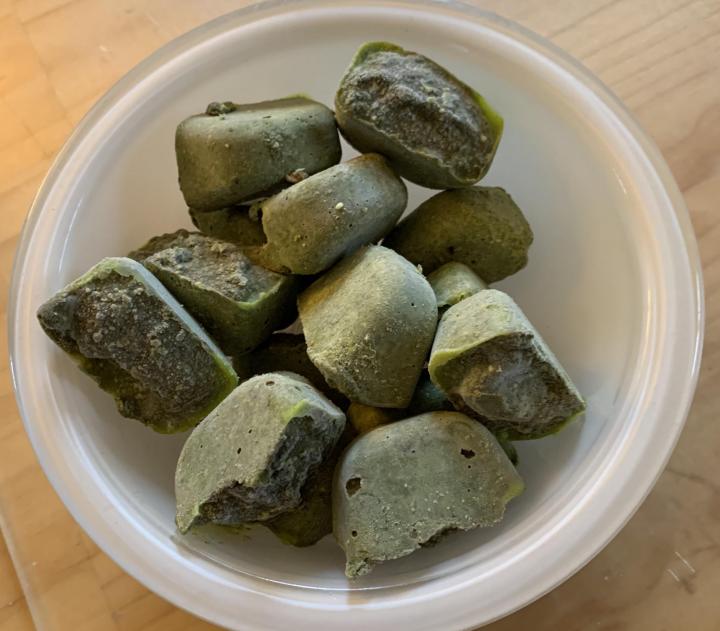
Image: Freeze pesto in ice cube trays to use all year!
More Pesto Recipes
You can make pesto out of other greens as well. Just substitute basil with spinach, especially if your spinach is starting to wilt.
See more pesto recipes below:
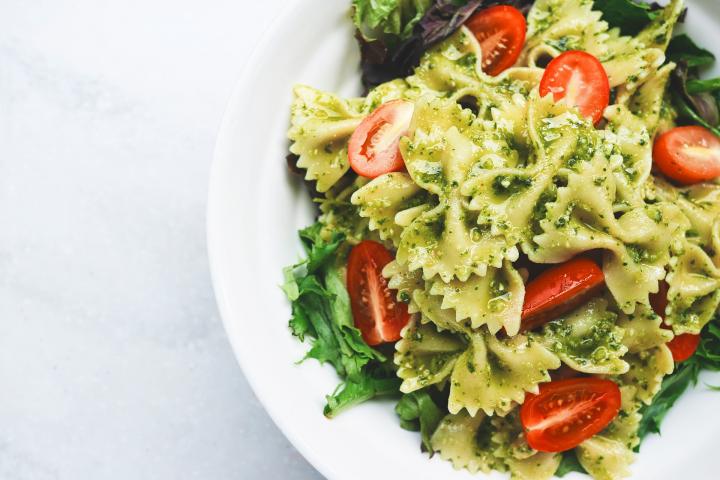
Image: Toss pesto with cooked pasta. Tomatoes also pair well with pesto.
How Do You Use Pesto?
Use it anywhere you think you’d like it. Spread pesto on sandwiches, toast, or crackers. Plop some into a soup or casserole, add it to sauces, use as a salad dressing or dip, mix it into any egg dish, smear it over chicken before (or after) baking.
Pesto can also replace the sauce on a pizza. And it’s excellent tossed with cooked pasta or vegetables as well as salmon or fish on the grill to add flavor.
Then there’s the classic Tomato, Basil, and Mozzarella Sandwich.
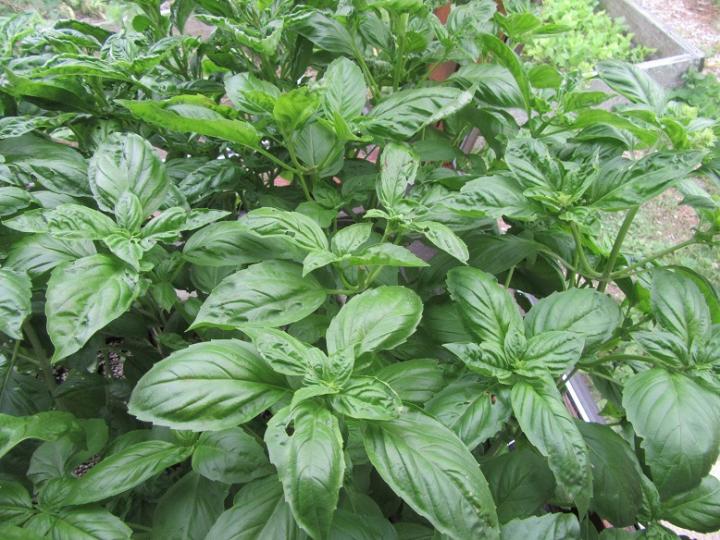
Image: Basil growing in my greenhouse. You can see how well it grows!
Grow Your Own Basil
Basil is one of the easiest plants to grow—any time of year. You don’t need a green thumb, a greenhouse, or a garden, only a pot (with a drainage hole or holes) filled with moist potting medium, and a few basil seeds or a handful of cut basil from the grocery store or a farmers market.
The larger your pot, the taller and bushier your basil plants will grow. You’ll also need a warm, sunny spot for your plants to grow in. If you don’t have a sunny spot, get a full-spectrum bulb for a light fixture and set the pot on a stand under the light for 10-12 hours a day.
If you plant seeds, water the planting medium well and plant shallowly, barely covering with soil, and water often but lightly until they sprout. Once the seedlings germinate, don’t overwater. Lightly water every couple of days at first, then only when the soil feels dry in the top half-inch or so. Your plants will also benefit from an occasional soil-wetting with a liquid organic fertilizer.
If you can secure a handful of fresh-cut basil from a store, neighbor’s garden, or farm, trim the ends of the cut stems, remove a couple of lower leaves until you have two or three inches of bare stem, and place the cuttings in a shallow glass of water. Change the water every couple of days to prevent bacterial growth. After a week or so, roots will begin to grow from the bare stems. When the roots have grown out an inch or two, poke in holes moist planting medium, and plant a rooted stem in each one, firming the soil up around the stems.
Once your plants are a few inches tall, pinch off the top two or three sets of leaves, including the stem. New leaves and branches will grow from where the stem was pinched. You’ll want to keep your plants well-pinched to prevent them from flowering. A flowering plant puts its energy into producing seed, and will stop producing large and flavorful leaves.
See the Almanac’s full Growing Guide for Basil.














